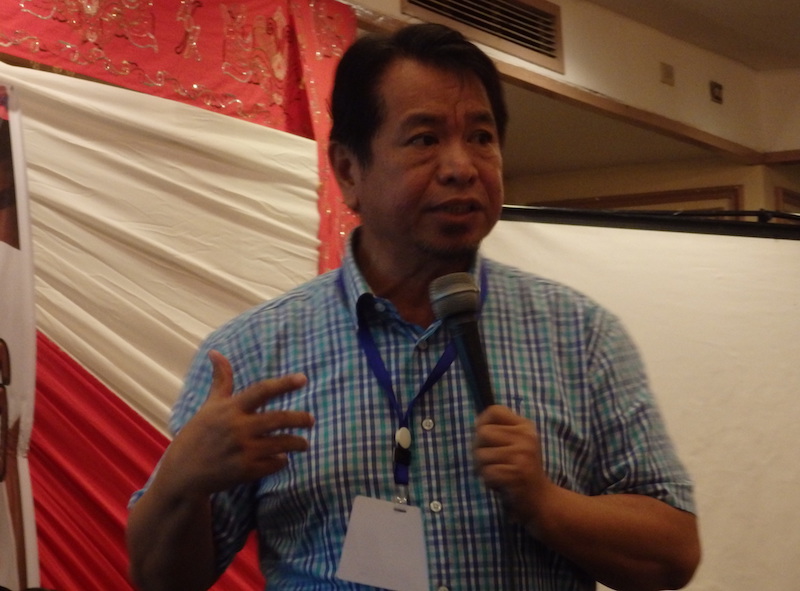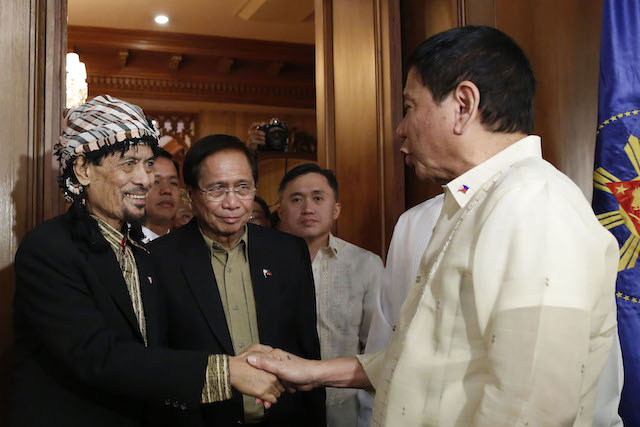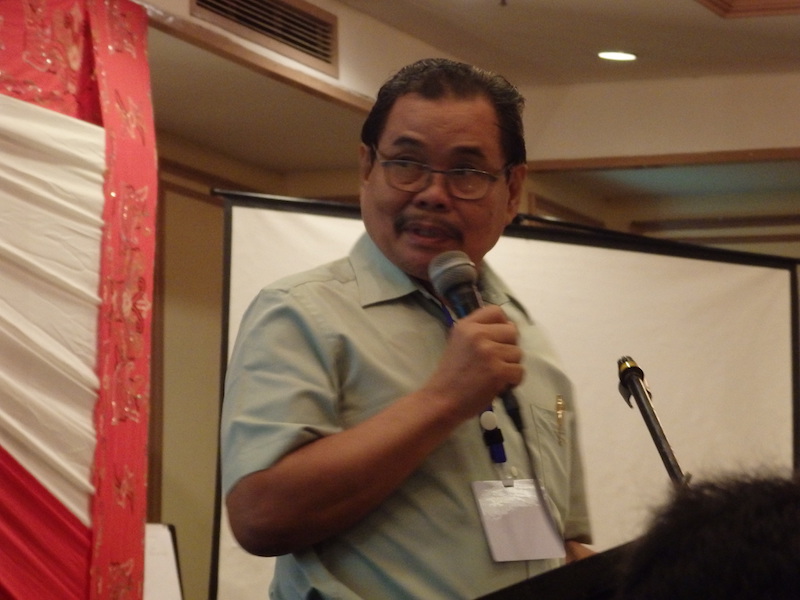Lawyer Randolph Parcasio will head the five-member peace implementing panel of the Moro National Liberation Front (MLNF) faction under founding chair Nur Misuari.
The panel was named by Misuari in a letter to President Rodrigo Duterte dated November 5, 2016 which he coursed through Presidential Adviser on the Peace Process Jesus Dureza, Parcasio told MindaNews.
Parcasio, chair of the Bangsamoro Lawyers Network, had served as Executive Secretary of the Autonomous Region in Muslim Mindanao (ARMM) under then Regional Governor Misuari. He was spokesperson of the MNLF in the Tripartite Review of the 1996 Final Peace Agreement (FPA) with government (GPH) and the Organization of the Islamic Cooperation (OIC), and had represented Misuari in international meetings, including the OIC-initiated Bangsamoro Coordination Forum.

Parcasio said the four other panel members are lawyer Yasser Lumbos, a B’laan who has been with the MLNF legal panel since 2007; lawyer Ombra Jainal, a Tausug and former regional director of the Department of Labor and Employment and Solicitor-General of the ARMM from 1996 to 2000; Dr. Alpikre Baser, a Meranaw doctor and chair of the Bangsamoro Parliament; and Lt. Col. Rajis Halipa, an MNLF integree to the Armed Forces of the Philippines, who is still in active service.
Irene Santiago, chair of the GPH peace implementing panel for the Bangsamoro Peace Accords, told MindaNews that the government panel that will deal with the Misuari panel will be chaired by Undersecretary Nabil Tan of the Office of the Presidential Adviser on the Peace Process. Tan was Sulu Vice Governor when he was a member of the government peace panel that negotiated with the MNLF from 1992 to 1996, and chaired the government team in the Tripartite Review with the MNLF and the Organization of the Islamic Cooperation.
Duterte received his personal friend Misuari in Malacanang on November 3, after a court ordered a six-month suspension of “proceedings and enforcement of warrants of arrest” against him to allow him to “to attend peace talk sessions with the government.”
Misuari was a fugitive from September 2013, when warrants of arrest were issued against him and 59 others for rebellion and violation of Republic Act 9851 or the Philippine Act on Crimes Against International Humanitarian Law, Genocide and other Crimes against Humanity following the armed confrontation in Zamboanga City between his followers and the military that left 137 persons dead (18 military, five police, nine civilians and 105 MNLF), 251 persons injured and 118,889 of the city’s 807,000 population displaced.
New autonomy law
In his presentation at the Kusog Mindanaw conference on federalism on November 30, Parcasio said their panel will work on a new autonomy law that would adhere to the letter and spirit of the 1996 FPA.
Parcasio said the Tripartite Review had found 46 infirmities in RA 9054, the law that amended RA 6734, the Organic Act creating the ARMM. RA 9054 was supposed to incorporate the 1996 FPA into an “expanded” ARMM law.

GPH panel refers to it as “42 consensus points” for 42 provisions that need to be revised, but explained that there was also consensus to delete four provisions in RA 9054 that did not adhere to the 1996 FPA.
Parcasio said 32 consensus points were agreed upon under the Arroyo administration which started the Tripartite Review in 2006 (its first meeting held a year later), and 14 others under the Aquino administration.
Three issues have yet to be resolved: territory in reference to the plebiscite that would be held to ratify the law; the transition mechanism which he said is similar to the Bangsamoro Transition Authority of the Moro Islamic Liberation Front (MILF) but “ours was the 1976 (Tripoli Agreement) version with some points coming from the 1996 (FPA) transitional mechanism; and revenue-sharing on strategic minerals or energy-based minerals.
The draft bill will be submitted to the President who will then submit it to Congress.
BAG and Mindanao State
Parcasio said the new autonomy law that they will draft will have as points of reference the 1976 Tripoli Agreement, the 1996 FPA, the executive summary during the proceedings (of the peace negotiations) from 1993 to 1996 and RA 9054.
He said the panel, which he refers to as “committee,” will sit with the government’s peace implementing panel “to draft a new autonomy law,” work on the executive doables as agreed upon during the Tripartite Review, and establish the Bangsamoro Development Assistance Fund that will be headed by the MNLF chair, among others.
Parcasio aso said the MNLF has “agreed to a federal republic with five rich and big states” – Mindanao, Visayas, Southern Luzon, National Capital, and Northern Luzon.
Parcasio ended his presentation by saying “the Bangsamoro Autonomous Government (BAG)” which shall be governed by the new autonomy law, be “approved before the ratification of the constitution of the Federal Republic.”
He said the BAG “shall be part of the Regional State Government of Mindanao.”
BBL first before Federal
The MILF which broke away from the MNLF when the dictator Ferdinand Marcos, using his executive and legislative powers under martial law, unilaterally implemented the 1976 Tripoli Agreement by creating two autonomous regions instead of one, also has a peace agreement with government, covering the same core territory of what is now the ARMM.

The MILF and GPH panels signed the Comprehensive Agreement on the Bangsamoro (CAB) on March 27, 2014.
President Duterte on November 7 signed Executive Order 8, expanding the membership of the Bangsamoro Transition Commission (BTC), the body that would draft the Bangsamoro Basic Law (BBL) to pave the way for the establishment of the Bangsamoro, a new autonomous political entity that would replace the ARMM.
The government’s Bangsamoro Peace and Development Roadmap targets July 2017 for the submission of the draft BBL. Initially, the roadmap envisioned an expanded BTC that would include members from the MNLF factions but Dureza told reporters on November 5 that Misuari will have a five-member panel while the MNLF under Muslimin Sema will have three seats out of the 10 government nominees in the BTC.
Dureza said he asked Misuari to “also organize a five-person panel” because “he doesn’t want to get involved with the MILF at all.”
Mohagher Iqbal, MILF peace implementing panel chair said the MILF supports the shift to a federal form of government “but it is in the sequencing that the MILF has a very clear position.”
He said the position of the MILF is to “pass the BBL first” because that is a government commitment “way ahead of the federalism discourse,” that the President during his campaign promise to make the BBL as a template for the federal government; that passing the BBL is “easier than shifting to federalism which is too complex,” and that the BBL should be the basic law in the region once the federal form of government is in place.
Convergence in Congress = “disaster”
President Duterte has yet to appoint the 21 members of the BTC and the MNLF panel has yet to meet with its counterpart.
Dureza told MindaNews on Nov. 3 that the GPH-MILF and GPH-MNLF (Misuari) peace tracks “will somehow converge in Congress without converging in the process.”
Parcasio said letting Congress do the “convergence” of the draft laws that the MNLF and MILF would craft, “would be a disaster.”
He said there must be “one common proposal of the MNLF and MILF” but how that can be done, “yan dapat natin pag-isipan” (that we should think about).
“Let us pray to Allah that the MNLF and MILF will come up with a common proposal,” he said.
http://www.mindanews.com/peace-process/2016/12/5-member-misuari-panel-named/

No comments:
Post a Comment
Note: Only a member of this blog may post a comment.